Histoire
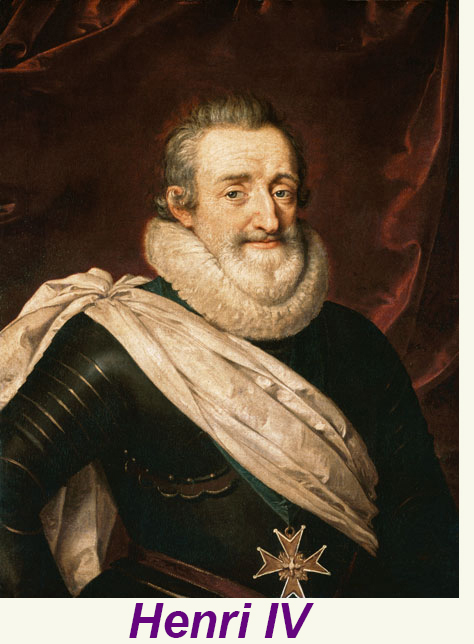 The original Régiment Bourbonnais was formed in the Province of Bourbonnais in south-central France in 1597. On March 6, 1597, King Henri IV commissioned Philibert Marquis de Nérestang to raise a regiment to fight in the Spanish War. It was raised from a "group of very select gentilhommes" and from some companies which had returned from Italy in 1591. The Marquis de Nérestang united these companies in what became the Régiment Bourbonnais. (The regiment bore the names of its colonels during the first years until February 1, 1673 when it assumed the designation of the Province of Bourbonnais.)
The original Régiment Bourbonnais was formed in the Province of Bourbonnais in south-central France in 1597. On March 6, 1597, King Henri IV commissioned Philibert Marquis de Nérestang to raise a regiment to fight in the Spanish War. It was raised from a "group of very select gentilhommes" and from some companies which had returned from Italy in 1591. The Marquis de Nérestang united these companies in what became the Régiment Bourbonnais. (The regiment bore the names of its colonels during the first years until February 1, 1673 when it assumed the designation of the Province of Bourbonnais.)
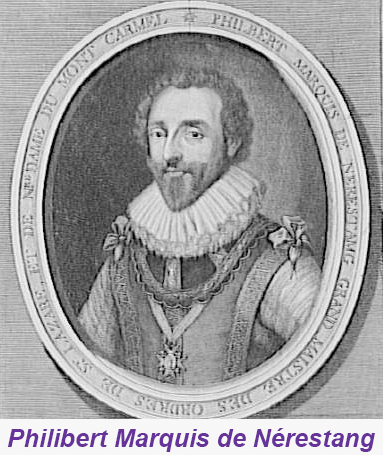 The regiment was dismissed on May 6, 1598 except for the company of the Mestre de Camp. The regiment was reconstituted on April 3, 1600 and was again dismissed on January 17, 1601. It was reinstated on May 31, 1602 and dismissed a third time in 1604. King Henry IV reinstated it on February 16, 1610, with de Nérestang bearing the cost of recruiting.
The regiment was dismissed on May 6, 1598 except for the company of the Mestre de Camp. The regiment was reconstituted on April 3, 1600 and was again dismissed on January 17, 1601. It was reinstated on May 31, 1602 and dismissed a third time in 1604. King Henry IV reinstated it on February 16, 1610, with de Nérestang bearing the cost of recruiting.
The War of Devolution
The Marquis de Castelnau commanded the Bourbonnais regiment in 1664. The regiment served at the sieges of Berghes, Furnes, Courtrai, Charleroi, Tournai, Douai, Oudenaarde and Lille in the War of Devolution. The regiment distinguished itself at the siege of Oudenaarde and the assault on the covered road of the Fort de Scarpe at Douai in this campaign.
The fact that Bourbonnais Infanterie, La Tour-du-Pin Infanterie and Auvergne Infanterie were all created during the same year gave rise to endless arguments about their respective ranking. King Louis XIV issued an edict in 1666 stating that each regiment would alternate for the 7th, 8th and 9th ranks on a yearly basis. The rank of the Bourbonnais as one of the “Petits vieux,” the little veterans, was established at this time.
The Franco-Dutch War
The Bourbonnais fielded two battalions of 16 companies each at the start of the Franco-Dutch war. They took part in the sieges of Orsoy and Zutphen in that campaign. They were in Utrecht in August. Seventeen companies were sent from there to garrison Wesel while the rest of the regiment, under Colonel de Castelnau, continued the campaign. The regiment then participated in the attack on a Dutch post near Ameide, where its colonel was mortally wounded. He was succeeded by Pomponne Marquis de Reffuges, who was appointed on February 1, 1673. The regiment was named after the Bourbonnais province at the same time.
The Régiment Bourbonnais was part of the force that covered the siege of Maastricht in 1673. It participated in the Battle of Seneffe in 1674 and engaged in the sieges of Dinant, Huy and Limbourg in 1675. It wintered in Maastricht and successfully defended that place in 1675. The regiment stayed in garrison in Maastricht for the rest of this war, except for some small detachments sent elsewhere. After peace with the Dutch had been concluded, the regiment fought an engagement at Minden and participated in the Siege of Luxembourg.
The Nine Years War
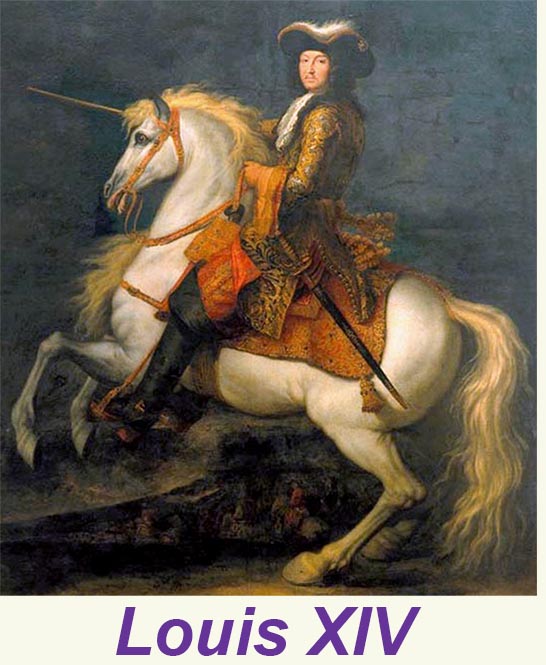 In 1687, under the reign of Louis XIV, the Marquis de Rochefort assumed command of the regiment. The first year of the Nine Years War, the Régiment Bourbonnais participated in the sieges of Philippsbourg, Mannheim and Frankenthal and then captured Kaiserslautern, Kreutznach, Neustadt, Oppenheim, Worms, Speyer and Mainz, where it wintered. The first battalion was in Landau and the second was at the defense of Mainz in 1689. The regiment stayed in Germany in 1690 and 1691 and went to Flanders in 1692. Here it engaged in the Siege of Namur (1) after which the third battalion was sent to Calais and the others fought at Steenkerque (2). The Régiment Bourbonnais covered itself in glory in this battle but had 300 men killed, including seven captains. The regiment participated in the siege of Furnes in December and then wintered in Arras.
In 1687, under the reign of Louis XIV, the Marquis de Rochefort assumed command of the regiment. The first year of the Nine Years War, the Régiment Bourbonnais participated in the sieges of Philippsbourg, Mannheim and Frankenthal and then captured Kaiserslautern, Kreutznach, Neustadt, Oppenheim, Worms, Speyer and Mainz, where it wintered. The first battalion was in Landau and the second was at the defense of Mainz in 1689. The regiment stayed in Germany in 1690 and 1691 and went to Flanders in 1692. Here it engaged in the Siege of Namur (1) after which the third battalion was sent to Calais and the others fought at Steenkerque (2). The Régiment Bourbonnais covered itself in glory in this battle but had 300 men killed, including seven captains. The regiment participated in the siege of Furnes in December and then wintered in Arras.
The regiment joined the main force in May 1693 and fought in the Battle of Neerwinden where nine captains were killed and five wounded. The Bourbonnais participated in the Siege of Charleroi at the end of the year and then remained in Flanders. It did not see much action, except for the action near Tongeren and the bombardment of Brussels in 1695. The regiment was sent to construct the fortifications of Neuf-Breisach in 1699. The Marquis de Nangis was appointed colonel of the regiment in 1700.
The War of Spanish Succession
The Régiment Bourbonnais was in Strasbourg in the first year of the War of Spanish Succession. It left that place in September 1702 and went to participate in the Battle of Friedlingen, where it lost 300 men. The regiment then wintered in Neubourg. The regiment was at the Siege of Kehl in February 1703 and then crossed into Germany. It was in the detachment of the Marquis d'Usson in the first battle of Höchstädt where it was accidently left behind in the village of Borhstadt. It would have been annihilated had Villars not arrived in time to win the battle.
The Bourbonnais was in Oberklauw in the Battle of Blenheim where it skilfully covered the retreat of Marsin's army. Back in Alsace, it had a fight with some Imperial cavalry in November. The regiment went to Metz to recruit at the beginning of 1705. It returned to the Rhine in August and worked on the bridge of Kehl. The regiment fought in the engagements near the lines of Weissembourg and Drusenheim in 1706 and at Sickingen and in the Lorch Valley in 1707. The regiment went to Flanders in 1708 and fought in the battle of Oudenaarde (3). During the siege of Lille, it was part of the main force.
Louis Antoine de Gramont Comte de Lesparre was appointed colonel of the regiment on January 1, 1709. The regiment was heavily engaged at Malplaquet, after which it went to Sedan. It was in Hesdin in 1710, and it guarded Abbeville in 1711. The Bourbonnais missed the battle of Denain in 1712, but it participated in the capture of Saint Amand and in the sieges of Douai and Quesnoi. Later, it was engaged in the Siege of Bouchain. The regiment covered the siege of Landau in 1713 and participated in taking Freibourg where it was placed in garrison. Part of the d'Esgrigny regiment was incorporated in the regiment after the peace of Rastadt (4).
The Bourbonnais Infanterie obtained precedence over the two other regiments (La Tour-du-Pin Infanterie and Auvergne Infanterie) in 1759. However, the conflict persisted and a new regulation, dated July 15 1761, reintroduced alternating ranks with Auvergne receiving the 7th rank for 1761 while the Bourbonnais got the 8th and Boisgelin (the new name of La Tour-du-Pin) was the 9th. The Bourbonnais Infanterie was the first French regiment to be designated as "Petits Vieux" because they pretended to trace their origins back to the old bands of the XVIth century.
The Seven Years War
The Regiment achieved particular distinction in the Seven Years War (1756-1763) against Frederick the Great and England. The Chevalier de Valence assumed command on August 17 1747 and was succeeded by the Marquis de Miran from February 20, 1761 to January 3 1770.
The regiment camped at Calais in 1756, where it was assigned to protect the French coasts between Calais and Ostende. The regiment was garrisoning Dunkerque in Flanders by August 1, 1757.
In 1760, the regiment was sent to Germany along with the Alsace Infanterie and the Normandie Infanterie. By May 23 1760, the regiment was part of the left reserve of the first line of Broglie's army, placed under the command of Saint-Germain. On July 31, the regiment took part in the Battle of Warburg where it was initially deployed en potence (flank) at the extreme left of the first line. At 1:30 PM, when the British grenadiers began to file through Ossendorf, the regiment retired without firing. However, when it was realized that the British grenadiers were aiming at a steep hill overlooking the French positions, two battalions of the regiment turned back and marched off to occupy the hill. A fierce struggle for the hill ensued, but the French were finally driven back. After the defeat, the regiment retired to Cassel. In November, it was in the action near Oldendorf. By December 30, the regiment had taken its winter quarters in Gilserberg.
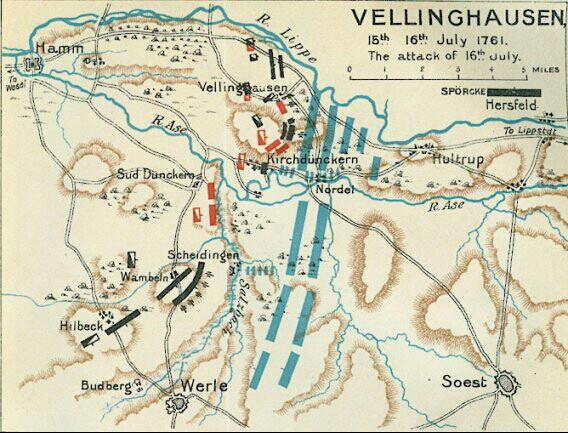 The 2nd and 3rd battalions of the regiment entered Warburg on February 13, 1761. The Allies, led by General Breitenbach, launched an assault on the town but were repulsed. During the Battle of Vellinghausen, on July 16, a detachment of volunteers of the regiment distinguished itself by capturing the village twice.
The 2nd and 3rd battalions of the regiment entered Warburg on February 13, 1761. The Allies, led by General Breitenbach, launched an assault on the town but were repulsed. During the Battle of Vellinghausen, on July 16, a detachment of volunteers of the regiment distinguished itself by capturing the village twice.
The regiment was stationed at Melsüngen, in the area of Göttingen, in 1762. It joined the army at Cassel on June 19 and took part in the Battle of Wilhelmsthal on June 24. The regiment then was stationed in Strasbourg in 1763.
The American War of Independence
The Régiment Bourbonnais, stationed in Corsica in 1776, was placed under the command of Anne Alexandre Marie Sulpice de Montmorency the Marquis de Laval on April 18, 1776. He retained the command throughout the American Revolution, relinquishing it to Charles-Louis-Victor Prince de Broglie on July 4, 1783. The Bourbonnais left Corsica and returned to Brittany later in 1776.
France signed the Treaty of Amity and Commerce and the Treaty of Alliance on February 6, 1778 which induced England to declare war against France in 1779. The Bourbonnais were ordered to occupy Rennes. They then went from there to Brest in June, where they embarked for America on April 7, 1780.
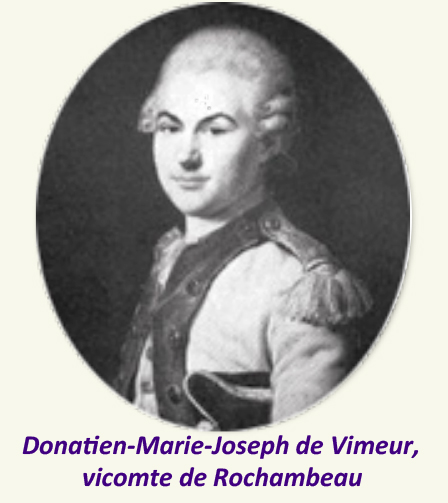 King Louis XVI honored the United States by sending one of his best regiments to her aid. The Bourbonnais was the oldest of the five regiments sent to America in 1780 under the command of Lieutenant General Jean Baptiste Donatien de Vimeur, Comte de Rochambeau to aid Gen. George Washington’s army. The compte's son, (Donatien-Marie-Joseph de Vimeur the Vicomte de Rochambeau) was the second-in-command of the Régiment Bourbonnais. The French Army landed at Newport, R.I. on June 11, 1780. Their encampment there tied down a large British force at New York.
King Louis XVI honored the United States by sending one of his best regiments to her aid. The Bourbonnais was the oldest of the five regiments sent to America in 1780 under the command of Lieutenant General Jean Baptiste Donatien de Vimeur, Comte de Rochambeau to aid Gen. George Washington’s army. The compte's son, (Donatien-Marie-Joseph de Vimeur the Vicomte de Rochambeau) was the second-in-command of the Régiment Bourbonnais. The French Army landed at Newport, R.I. on June 11, 1780. Their encampment there tied down a large British force at New York.
The Bourbonnais sailed from Newport aboard Admiral Destouche’s ships Ardent and Jason in March 1781. Admiral Arbuthnot’s British squadron engaged them off the Chesapeake Capes on March 16. Both squadrons were about equally damaged. Arbuthnot sailed into the Chesapeake while Destouche returned to Newport.
The March to Yorktown
The Régiment Bourbonnais was selected to be Rochambeau's bodyguard and was additionally honored by being selected as the vanguard of the French Army as it left Newport on June 18, 1781 to join with the Americans. They marched across Connecticut, around New York City and down the coast to Virginia where they arrived in late September.
During the period of July 1-3, 1781, the regiment was placed in reserve in the allied French-American reconnaissance force at the northern end of Manhattan Island. The Bourbonnais joined the rest of the French division and the American force at Philipsburg, NY on July 6th.
A detachment of 2,500 men from the Bourbonnais and Royal-Deux-Ponts regiments joined the "compagnies d'élite de Soissonnais," commanded by the Chevalier de Chastellux to reconnoiter around Kingsbridge on July 21. They forced the English to withdraw all their posts.
The French crossed the Hudson River at Verplanck's Point on August 23 and 24, 1781, in preparation for the Allied Army's march south. They marched by way of Trenton, Philadelphia and Chester to Baltimore, Annapolis and Head of Elk where they found boats to take them to Yorktown, Virginia.
When the French troops arrived at the outskirts of Philadelphia after a remarkable march in an excessive heat, they halted to arrange their clothing before marching into the city. The houses were decked with flags of the two nations. The army passed in review before the members of Congress who had assembled to honor them. The entire population fêted them during their one-day visit there.
They learned that the fleet of the Count de Grasse had just entered the Chesapeake. They marched to the bay, where some companies were embarked. The rest of the troops were sent to Baltimore and thence to Annapolis, where they found transports ready for them.
The two fleets passed through the bay and entered the James River. The Count de Rochambeau regiments of Bourbonnais, Soissonnais, Saintonge, and Royal-Deux-Ponts and the Auxonne artillery joined with those which the Count de Grasse had brought from the Antilles under the command of the Marquis de Saint-Simon [the regiments d'Agénois, Gatinais (soon after named Royal-Auvergne), and Touraine] made an effective force of about 7,500 men.
They joined the American force on September 28 which had trapped the army of Lord Charles Cornwallis at Yorktown. The Bourbonnais captured Pigeon Hill outside Yorktown on September 30, 1781. The regiment manned the trenches around Yorktown on the night of October 6. They vigorously repelled Lt. Col. Robert Abercromby's attack on the second parallel on the 18th.
The American and French Infantry captured the outer British lines on the night of October 14. The British surrendered five days later, ending the last major campaign of the Revolutionary War which prompted the British government to eventually negotiate an end to the conflict.
Aftermath
Following the surrender of Yorktown, the Bourbonnais spent the winter at Williamsburg, VA. They marched north to the Hudson River, Providence, RI and finally, to Boston, MA in the summer and fall of 1782. They embarked for the West Indies on December 21, 1782.
They went to Rhode Island in March 1783 where the fleet of M. de Vaudreuil awaited to take them back to France. One of M. de Vaudreuil’s vessels, having been lost in a tempest, the United States gave a touching example of gratitude to France by making a gift to that nation of the first vessel of war which the new United States of America had constructed, the only one which they possessed at that time, the 74-gun America.
Upon their arrival in France, the Bourbonnais were sent to Metz. The regiment changed its name in 1791 and became the 13th regiment of infantry. The 13th regiment of infantry stationed at Nevers descends from this regiment. It clung tenaciously to its gallantly earned motto "En Avant Sur les Canons" (advance on the cannons) throughout World War I (5).
François-Henri Baron de Poutet was appointed to command the Bourbonnais on November 23, 1791. He was succeeded by Louis-François-Pierre Le Chevalier d'Aulande de Salton on May 8, 1792.
Notes
1. 'Bataille welche ihr. Königl. Maj. von Frankreich wieder die alijrten vor Namur in Braband den 24 July 1692 gestellet haben' HStAM WHK 8/115.
2. Bataille formée par les François contre les Alliées près de Steinkerque en Braband en l'année 1693 (actually 1692). in Susane, Louis. Histoire de l'ancienne infanterie française. Paris: J. Corréard, 1849-1853. volume III, pp. 290-293
3. Ordre de bataille sous son altesse le prince et Duc de Bourgogne au camp de Soigny le 26 Mai 1708.
4. Histoire de l'ancienne infanterie française volume III, page 293
5. Mérou, Henri; France. Ministère des affaires étrangères. Les combattants français de la guerre américaine 1778-1783. Listes établies d'après les documents authentiques déposés aux Archives nationales et aux Archives du Ministère de la guerre. Paris, Ancienne maison Quantin, Libraries-imprimeries reúnies, Motteroz, Martinet, 1903. Pp. 253-255.

